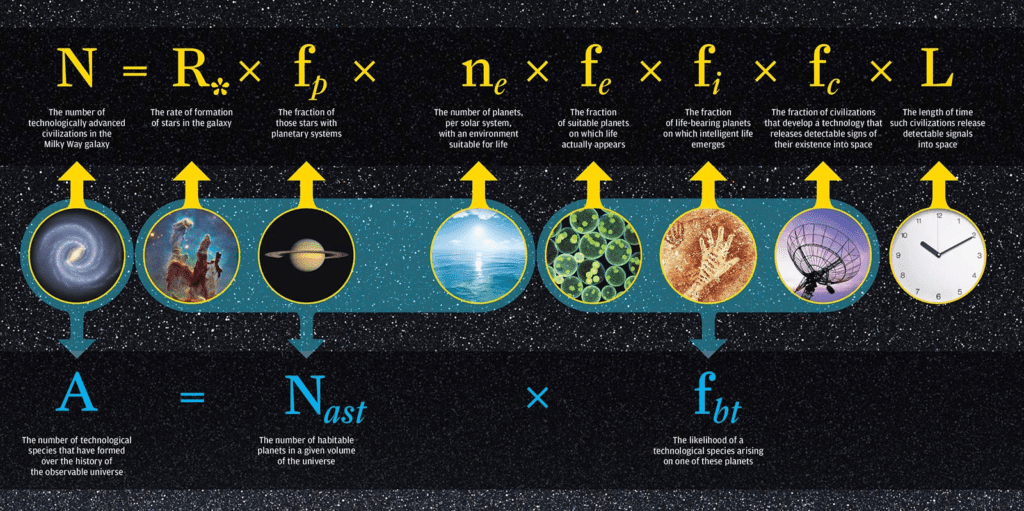Unlocking the Mysteries of the Universe: Could there be extraterrestrial life and what might it be like?
Introduction
For millennia, humans have gazed at the night sky, pondering the age-old question: “Are we alone in the universe?” The quest to discover extraterrestrial life has captivated our collective imagination, driving scientific exploration, sparking wild speculations, and inspiring countless works of science fiction. As we stand on the precipice of technological advancements and space exploration, the tantalizing possibility of finding life beyond Earth is closer than ever. In this article, we will delve into the fascinating realm of astrobiology, exploring the scientific endeavors, discoveries, and the tantalizing mysteries surrounding the potential existence of extraterrestrial life.
The Quest for Extraterrestrial Life: A Brief History
Human curiosity about life beyond our planet can be traced back to ancient civilizations. The Greeks, for instance, speculated about other worlds and the existence of celestial beings. However, it wasn’t until the advent of modern science and technology that the quest for extraterrestrial life became a rigorous scientific pursuit.
1. The Birth of Astrobiology
Astrobiology, the interdisciplinary field that seeks to understand the potential for life beyond Earth, officially emerged in the 20th century. The 1960s and 70s witnessed significant milestones with the exploration of Mars and the moon, as well as the search for microbial life in extreme environments on Earth.
Today, astrobiology encompasses various scientific disciplines, including biology, chemistry, astronomy, and planetary science, all working in tandem to unlock the secrets of the cosmos.

2. The Drake Equation and SETI
In 1961, the American astrophysicist Dr. Frank Drake formulated the famous Drake Equation, a probabilistic formula aimed at estimating the number of extraterrestrial civilizations in our galaxy that could potentially communicate with us. This equation serves as a foundation for the search for extraterrestrial intelligence (SETI), a scientific effort that continues to this day.
3. Encouraging Discoveries: Mars and Beyond
Exploration of our neighboring planets has been a focal point in the search for extraterrestrial life. Mars, with its intriguing history of water, has been a prime target. Robotic missions like the Mars rovers have unearthed compelling evidence of the planet’s watery past and the potential habitability of certain regions.

The Building Blocks of Life
To comprehend the potential for extraterrestrial life, we must first understand the fundamental building blocks of life as we know it. Life on Earth is characterized by certain key elements and molecules that form the basis of all living organisms.
1. Water: The Elixir of Life
Water is an essential ingredient for life as we know it. It serves as a universal solvent, providing a medium for chemical reactions to occur. On Earth, water is abundant, and its presence is closely linked to the development of life. Scientists often look for signs of water when searching for habitable environments on other planets or moons.
2. Carbon-Based Chemistry
Carbon is the backbone of organic molecules, the foundation of life on Earth. The versatility of carbon allows it to form complex, stable molecules, such as amino acids, nucleotides, and lipids. This carbon-based chemistry is a fundamental requirement for life.
3. Energy Sources
Life requires a source of energy to fuel its processes. On Earth, the primary sources of energy are the Sun’s radiation and chemical reactions. Photosynthesis, for example, harnesses solar energy to convert carbon dioxide and water into glucose and oxygen.
4. The Search for Exotic Chemistry
While Earth’s life is carbon-based, scientists remain open to the possibility of alternative biochemistries. Silicon, for instance, shares some chemical similarities with carbon and has been explored in the search for extraterrestrial life. The hunt for exotic chemistries broadens the scope of potential habitats for alien life forms.
Extremophiles: Life Finds a Way
One of the most astonishing revelations of modern science is the discovery of extremophiles—microscopic organisms that thrive in extreme environments previously considered inhospitable to life. These remarkable creatures expand our understanding of where life might exist beyond Earth.
1. Thermophiles
Thermophiles are heat-loving organisms that flourish in scorching environments, such as hydrothermal vents deep within the ocean floor. These environments are rich in minerals and chemicals that could potentially support life on other celestial bodies, like the icy moons of Jupiter and Saturn.
2. Acidophiles
Acidophiles are acid-loving microbes that thrive in highly acidic conditions, such as sulfuric acid pools. The discovery of acidophiles has implications for the search for life on other planets, particularly those with acidic atmospheres or volcanic activity.
3. Halophiles
Halophiles are salt-loving organisms that inhabit saline environments, including salt flats and hypersaline lakes. Their existence suggests that salt-rich environments on Mars or the icy moon Europa might harbor life.
The Goldilocks Zone: Habitable Planets
One of the central concepts in astrobiology is the notion of the “Goldilocks zone,” also known as the habitable zone. This is the region around a star where conditions are just right for liquid water to exist on the surface of a planet—a crucial ingredient for life as we know it.
1. The Role of Stellar Characteristics
The habitable zone’s location depends on the type and characteristics of the star around which a planet orbits. Stars come in various sizes, temperatures, and luminosities, each influencing the habitable zone’s position. The search for exoplanets within these zones has been a priority for astronomers.
2. Exoplanets: The Search for Habitable Worlds
The discovery of exoplanets—planets orbiting stars outside our solar system—has opened up new avenues in the quest for extraterrestrial life. Researchers have identified thousands of exoplanets, some of which reside within their star’s habitable zone. Prominent examples include Proxima Centauri b and TRAPPIST-1e.
The Fermi Paradox: Where is Everybody?
As our understanding of the universe expands, we are confronted with a perplexing conundrum: the Fermi Paradox. Named after physicist Enrico Fermi, this paradox questions why, given the vast number of potentially habitable planets in the galaxy, we have not yet encountered extraterrestrial civilizations.
1. The Drake Equation Revisited
The Drake Equation, which initially fueled optimism about the prevalence of extraterrestrial civilizations, raises new questions in light of the Fermi Paradox. Despite the calculations suggesting a high probability of alien life, we have yet to detect any conclusive evidence.
2. Possible Explanations
Several hypotheses attempt to explain the silence of the cosmos:
- Rare Earth Hypothesis: This posits that the conditions necessary for complex life are exceptionally rare, making Earth an anomaly.
- The Great Filter: This concept suggests that some catastrophic event or obstacle prevents civilizations from advancing to the stage of interstellar communication.
- Zoo Hypothesis: Speculates that advanced extraterrestrial civilizations are intentionally avoiding contact with us, similar to a cosmic “prime directive.”
3. The Role of Technology
The Fermi Paradox also raises questions about the development of advanced technology. Could civilizations destroy themselves before reaching a stage of interstellar exploration, as humanity faces the challenges of climate change and nuclear proliferation?
The Search for Extraterrestrial Intelligence (SETI)
While the Fermi Paradox may cast doubt on the existence of extraterrestrial civilizations, the search for extraterrestrial intelligence (SETI) continues unabated. This concerted effort to detect signals or signs of intelligent life beyond Earth is a beacon of hope in the quest for contact with other beings.
1. Radio Telescopes: Eavesdropping on the Universe
SETI researchers use powerful radio telescopes to scan the skies for artificial radio signals that could indicate intelligent communication. The famous Arecibo Observatory in Puerto Rico and the Allen Telescope Array in California are among the facilities dedicated to this purpose.
2. METI: Messaging to Extraterrestrial Intelligence
In addition to passive listening, some scientists advocate for active communication with potential extraterrestrial civilizations through METI (Messaging to Extraterrestrial Intelligence). Initiatives like the Lone Signal project have transmitted messages into space, raising ethical and safety concerns about announcing our presence to the unknown.
3. The Role of Artificial Intelligence
Advancements in artificial intelligence have become a valuable tool in the search for extraterrestrial intelligence. Machine learning algorithms can analyze vast amounts of data, helping scientists identify potentially significant signals amidst the cosmic noise.
Beyond Microbes: Intelligent Extraterrestrial Life
While much of the focus in the search for extraterrestrial life centers on microbial organisms, the possibility of intelligent extraterrestrial civilizations captivates our imagination. Could there be advanced beings out there, capable of interstellar travel and communication?
1. The Evolution of Intelligence
On Earth, intelligence is a product of evolution, driven by natural selection. It has allowed species like humans to develop complex societies, advanced technology, and the capacity for space exploration. Could a similar process have occurred on other worlds?
2. Challenges of Interstellar Travel
The vast distances between stars present a formidable challenge for any civilization aspiring to explore the cosmos. Even with theoretical concepts like warp drives and wormholes, the feasibility of interstellar travel remains uncertain. This raises questions about the potential limitations on the expansion of intelligent life in the universe.
3. The Search for Technosignatures
In addition to searching for microbial life and radio signals, scientists are exploring the concept of technosignatures—indicators of advanced technology or industrial activity. These could include the detection of megastructures, artificial atmospheres, or other anomalies that suggest the presence of intelligent civilizations.
Ethical and Philosophical Considerations
As we venture deeper into the realm of astrobiology and the search for extraterrestrial life, we encounter a range of ethical and philosophical questions that demand careful consideration.
1. Planetary Protection
The exploration of other celestial bodies, such as Mars, must adhere to strict planetary protection protocols to avoid contaminating these environments with terrestrial microbes. Preserving the integrity of potentially habitable worlds is a paramount ethical concern.
2. Contact Protocols
If we were to make contact with extraterrestrial civilizations, protocols for communication and interaction would be essential. How do we ensure peaceful and mutually beneficial encounters? Avoiding unintended consequences or conflicts is a paramount concern.
3. Our Place in the Universe
The discovery of extraterrestrial life would have profound philosophical implications. It would force us to reevaluate our position in the cosmos, our understanding of life’s origins, and our place in the grand tapestry of the universe.
Conclusion
The quest for extraterrestrial life is an ongoing journey of scientific exploration, philosophical reflection, and technological advancement. While we have not yet uncovered definitive evidence of alien existence, the pursuit of this profound question continues to inspire wonder, curiosity, and a deeper understanding of our place in the cosmos. As we peer into the starry abyss, we remain open to the possibility that one day, we may discover that we are not alone in the universe.
Explore Further:

